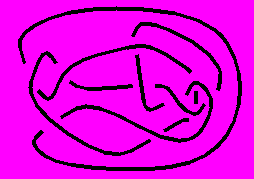
The bad thing about working with a knotted rope is that after you have moved the rope around to show how the knot can be changed from one twisty form to another, you can't always get it back to the way it was or remember what you did to change the first knot into the second one.
The good thing about a drawing of a knot on paper is that it stays put! It isn't going to twist itself into a different drawing of the same knot.
The bad thing about a drawing of a knot on paper is that when you look at it and try to imagine different ways that it could be changed around, your eye and your brain get tangled up too. It can be very hard to simply imagine how the strands in the picture could get moved around without being able to move. them.

Did you get lost? Did you make mistakes? Did you have to start over? Was it hard?
Some of the ways that I goof them up are:
So I practice drawing them. I draw them in different colors, I draw them big and small. I go over the lines of knots that I have drawn and shade them in so they look pretty and interesting. It looks like I am fooling around, doodling and daydreaming, but I'm not. These knots are hard to draw. The more I practice, the better I get.

Without looking at it again. Draw it from memory.
Did you go crazy? How much did you have to practice before you could do it?
IMPORTANT CONCLUSION #2: There must be a whole lot of information in these drawings, otherwise you could look at a drawing and remember what was there long enough to draw it.
Look at the sheet of knot diagrams and make beautiful drawings of knots that look interesting to you. Put the pages together to form a book.
I'm not as good at it as I wish I was, but a chalkboard has been the key to my recent successes. It's so simple! If you draw the knot on a chalkboard, you can erase lines and redraw them to change the knot around. When I first started doing that, I was trying to do things like making the knot in the picture below into a simpler version of itself:

It was really hard at first. I just wasn't sure what to change or how to change it. But after I had practiced a while I started noticing "moves" that I could make that always made the knot simpler without changing it.
What I liked the most about doing this was how fast I got good at it. When I started, I felt really clumsy and dumb. After just a little bit of practice, I was saying things to myself like, "I know what to do."
You can tie an extension cord into any kind of a knot and then join the ends by plugging it into itself. What a discovery!
I still like tying knots with rope and connecting the ends with duct tape. They make nice sturdy knots that feel better in your hands than an extension cord, really. Unfortunately, I have a whole grocery bag full of knots made out of rope and duct tape that are all mixed up. It will take me forever to match them up with the knots on the sheet of knot diagrams, and it's a lot of trouble to take them apart and start over with them. So now when I want to experiment with a knot, but I don't necessarily want to keep that knot forever, I reach for the handy-dandy extension cord.